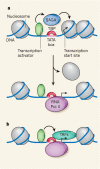Transcription. Gene expression--where to start?
- PMID: 19095933
- PMCID: PMC3516868
- DOI: 10.1126/science.1168805
Transcription. Gene expression--where to start?
Figures

Comment on
-
RNA exosome depletion reveals transcription upstream of active human promoters.Science. 2008 Dec 19;322(5909):1851-4. doi: 10.1126/science.1164096. Epub 2008 Dec 4. Science. 2008. PMID: 19056938
-
The antisense transcriptomes of human cells.Science. 2008 Dec 19;322(5909):1855-7. doi: 10.1126/science.1163853. Epub 2008 Dec 4. Science. 2008. PMID: 19056939 Free PMC article.
-
Divergent transcription from active promoters.Science. 2008 Dec 19;322(5909):1849-51. doi: 10.1126/science.1162253. Epub 2008 Dec 4. Science. 2008. PMID: 19056940 Free PMC article.
-
Nascent RNA sequencing reveals widespread pausing and divergent initiation at human promoters.Science. 2008 Dec 19;322(5909):1845-8. doi: 10.1126/science.1162228. Epub 2008 Dec 4. Science. 2008. PMID: 19056941 Free PMC article.
References
Publication types
MeSH terms
Substances
Grants and funding
LinkOut - more resources
Full Text Sources
Molecular Biology Databases

